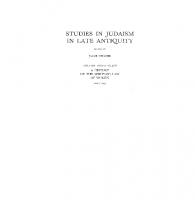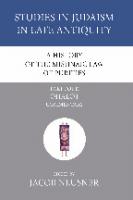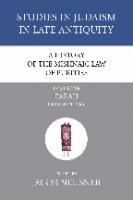A History of the Mishnaic Law of Women, Part 2: Ketubot: Translation and Explanation (Studies in Judaism in Late Antiquity) 9781556353567, 1556353561
The history of Jews from the period of the Second Temple to the rise of Islam. From 'A History of the Mishnaic Law
120 106 12MB
English Pages 166 [167] Year 2007
TABLE OF CONTENTS
CHAPTER ONE
CHAPTER TWO
CHAPTER THREE
CHAPTER FOUR
INDEX
Recommend Papers

- Author / Uploaded
- Jacob Neusner (editor)
File loading please wait...
Citation preview
A HISTORY OF THE MISHNAIC OF WOMEN PART TWO
LAW
STUDIES IN JUDAISM IN LATE ANTIQUITY EDITED BY
JACOB NEUSNER
VOLUME
THIRTY-THREE
A HISTORY OF THE MISHNAIC OF WOMEN PART TWO
LAW
A HISTORY OF THE MISHNAIC LAW OF WOMEN BY
JACOB NEUSNER University Professor Professor of Religious Studies The Ungerleider Distinguished Scholar of Judaic Brown University
Studies
PART TWO
KETUBOT TRANSLATION
AND EXPLANATION
Wipf&Stock PUBLISHERS Eugene, Oregon
Wipf and Stock Publishers 199 W 8th Ave, Suite 3 Eugene, OR 97401 A History of the Mishnaic Law of Women, Part 2 Ketubot: Translation and Explanation By Neusner, Jacob Copyright©1980 by Neusner, Jacob ISBN 13: 978-1-55635-356-7 ISBN 10: 1-55635-356-1 Publication date 3/20/2007 Previously published by E. J. Brill, 1980
To The Trustees of Columbia University zn the City of New York in gratitude for The University Medal for Excellence awarded to me on May 15, 1974.
TABLE OF CONTENTS Preface.................................................. Abbreviations and Bibliography. . . . . . . . . . . . . . . . . . . . . . . . . . . . . Transliterations. . . . . . . . . . . . . . . . . . . . . . . . . . . . . . . . . . . . . . . . . . . Introduction.
I. II. III. IV. V. VI. VII. VIII. IX. X. XI. XII. XIII.
.............................................
Ketubot Ketubot Ketubot Ketubot Ketubot Ketubot Ketubot Ketubot Ketubot Ketubot Ketubot Ketubot Ketubot
Chapter Chapter Chapter Chapter Chapter Chapter Chapter Chapter Chapter Chapter Chapter Chapter Chapter
One ............................. Two ............................. Three ............................ Four. ............................ Five ............................. Six .............................. Seven ............................ Eight. ............................ Nine ............................. Ten .............................. Eleven ........................... Twelve ........................... Thirteen ..........................
Index............................................
. . . . . . . . . . . . .
IX
xrn xx 1 13 22 33 40
52 64 75 84 97 108 118
125 132 140
PREFACE This book, dealing with Mishnah-Tosefta Ketubot, continues the work of translating and explaining the Mishnaic law of women. The translation is meant to highlight form-analytical traits and problems, and the explanation, to give a clear and straight-forward account of the exegetical results of form-analysis and so to spell out the original and primary, historical meaning intended by the framers of the several pericopae and of the tractate as a whole. Tosefta is dealt with in a perfunctory way, principally as a commentary on Mishnah. I no longer accord to Tosefta status as an independent object of exegesis, but allow that compilation to play only a limited role in what follows. The translation and explanation serve a single, very particular purpose, and in no way address all, or even most, of those many exegetical problems which occupy the great classical literature of Mishnah-exegesis and study of the halakhah of Mishnah and Talmud. My notion is that I herein explain what it is that the people who made up these sentences meant at the time that they made them up. The exclusion, of course, is self-evident: all those many issues generated by later thinkers and addressed to these same sentences for their (implied) judgments and responses. The intellectual structure and history of Rabbinic Judaism are one of the formidable achievements of the human mind. Surely an account of what lies at the very foundations of that structure and at the commencement of that history serves its purpose (achieved in the concluding part of the whole) without having to attend to those many legitimate issues and interests which arose later on, after Mishnah came to closure. Many times I have contemplated presenting only the conclusions, without an account of the texts and the meanings I believe inhere in their original form and sense. Each time I have concluded that conclusions without texts serve no important scholarly purpose, even though, at the outset, the work of discovery and presentation would be greatly facilitated for me, and the reception of the results made easier for the reader. Just as each division of Mishnah takes for granted the existence of the others, so no work on Mishnah may pretend to accomplish the whole of the work of description, interpretation, and philosophico-legal reconstruction and to take up the pretense that other works of reference and of scholarship are unavailable. One minor consequence is that I do not even trouble to list parallel passages, e.g., where a given pericope of Mishnah
X
PREFACE
or Tosefta is alluded to or cited; these are exhaustively listed, for Tosefta, in Lieberman, and, for Mishnah, in Romm's edition. One major consequence is that, when I offer my simple conception of what it is that a pericope wishes to tell us at the very commencement of its historical journey, I no longer trouble to report other conceptions and why I reject them. Yet another is that, for the radically limited purposes of the present work, I follow the text and pointing of Albeck-Y alon, rather than assembling a selection of the variant readings available in MSS, Geniza fragments, references to Mishnah-Tosefta in earlier strata of the exegetical literature, and the like. For this tractate, moreover, that work has been done-and superbly done, it seems to me-by Hutner and his colleagues. As I followed the assembly of variant readings, I could never see why for historical purposes-as distinct from legal or exegetical purposes of a different order entirely-one reading made much difference over another. Accordingly, I translate what Albeck has given us, though, if the reader of this work in particular wishes to see the further possibilities, turning to Hutner will show many others. A glance at the volumes of translation and explanation of Purities and Holy Things will indicate how little substantive difference is contributed by an assembly of variants. Let me now specify what the work aims to achieve. The purpose of the present work is to investigate the history of the formation of Rabbinic Judaism, down to the redaction of Mishnah in ca. 200. Even though attainment of that purpose presently seems remote, depending as it does upon the completion of the historical analysis of all of Mishnah-Tosefta, we have to keep in mind why we do the work and what we hope to learn. The sole issue here is historical. All discussion, both in the four exegetical parts and in the synthetic one to follow, is shaped to address the historical question announced in the title of the work. Questions of the history of exegesis and of the formation, formulation, transmission, and redaction of the literature of Mishnah-Tosefta, to which a fair amount of intellectual energy is devoted in Purities, here are not raised, as they were not dealt with at length in Holy Things. The reason is that the answers to these questions do not materially advance the single inquiry at hand, an investigation of the history of religions and of ideas. Methods for the finding of answers to certain long-standing literary and exegetical questions have proved their validity and do not require further demonstration in the present work. To conclude: this work is not called a commentary,but "translation and explanation," which I hope will more adequately define and delimit my
PREFACE
XI
purpose. A commentary may serve any number of useful and important purposes. It may be "scientific," that is, as the word is presently used, archaeological or philogical. It may raise a wide range of quite distinctive and valid exegetical purposes, e.g., harmonistic, halakhic, atomistic, textcritical, and the like. It may constitute a supercommentary, not to Mishnah at all, but to a particular trend of Mishnah-commentaries. My contribution is defined by my purpose, to repeat: to attain a history of the Mishnaic law of women. The history cannot be laid forth without a systematic, careful, and complete presentation of the relevant sources. This is accomplished in the translation. These sources have also to be interpreted and explained, since no reader can be expected to effect the rather complex task of exegesis only at the time of turning to what I might offer in Part V as the history of these (by me, unexplained) texts. That is why, in addition to a fresh translation (the first in English of Tosefta, the first form-analytical one for Mishnah), I offer what I call an explanation, as I said, a simple and straightforward account of what I believe each pericope meant to the person who made it up. Turning directly to the historical parts of the project without first learning the texts upon which they arc based will not serve any useful purpose. This book and its successors thankfully are dedica_ted to those universities which, in various ways, have chosen in the past few years to grant recognition to my scholarly efforts.
J.N,
ABBREVIATIONS AE Ah Albeck Ar. Arthur A.Z.
-
B. B.B. B.M. B.Q. Baer
-
Bailey Beauvoir Ber. Berger
=
Berlin, 1968 Berlin, 1972 Berlin, 1971 Bert. Bes. Bik. Blackman
=
C Cohen Cohen, Law Cohen, Roman Law
=
Corbett
=
Daiches
Daly Dem. Deut.
& Slotki
AND BIBLIOGRAPHY
Tosafot R. 'Aqiba Egger. From Mishnah, ed. Romm. 'Ahilot I;Ianokh Albeck, Shishah sidri mishnah. Seder Nashim (Tel Aviv, 1954). 'Arakhin Marylin B. Arthur, "The Origins of the Western Attitude to• ward Women," Arethusa 6, 1973, pp. 7-58. cAbodah Zarah Babylonian Talmud Baba' Batra' Baba' Me~i'a' Baba' Qamma' Richard A. Baer, Jr., Phi/o's Use of the CategoriesMale and Female (Leiden, 1970). Derrick Sherwin Bailey, Sexual Relation in Christian Thought (N. Y., 1959). Simone de Beauvoir, The Second Sex. Translated and edited by H. M. Parshley (N.Y., 1953). Berakhot Isaiah Berger, ed., Analytical Index to The Jewish Quarterly Review, 1889-1908 (N.Y., 1966). Charles Berlin, Harvard University Library. Catalogue of Hebrew Books (Cambridge, 1968), I-VI. Supplement (Cambridge, 1972), I-III. Widener Library Shelflist, 39. Judaica (Cambridge 1971). 'Obadiah of Bertinoro. From Mishnah, ed. Romm. Be~ah Bikkurim Philip Blackman, Mishnayoth. Vol. III. Order Nashim. Pointed Hebrew Text, Introductions, Translation, Notes, Appendix, Supplement, Indexes (London, 1954). H. Loewe, The Mishnah of the Palestinian Talmud (Hammishnah 'al pi ketab-yad Cambridge) (Jerusalem, 1967). A. Cohen, Sotah. Translated into English with Notes, Glossary, and Indices (London, 1936). Boaz Cohen, Law and Tradition in Judaism (N.Y., 1959). Boaz Cohen, Jewish and Roman Law. A Comparative Study (N. Y., 1966) I-II. See Smith re Cohen. Percy Ellwood Corbett, The Roman Law of Marriage (Oxford,
1930). Samuel Daiches and Israel W. Slotki, Kethuboth. Translated into English with Notes, Glossary, and Indices. Pages 1-198 by Samuel Daiches [ - b. Ket. 2a·36b]. Pages 198 to the end by Israel W. Slotki [ = b. Ket. 36b = 112b] (London, 1936). Mary Daly, Beyond God the Father (Boston, 1973). = Dema'i = Deuteronomy
XIV
Donaldson Douglas Meanings
ABBREVIATIONS
AND
BIBLIOGRAPHY
James Donaldson,
Woman. Her Position and Influence in Ancient Greeceand Rome, and Among the Ear/y Christians (N.Y., 1907). Mary Douglas, Implicit Meanings. Essays in Anthropology (London
Boston, 1975). Mary Douglas, Natural Symbols. Explorations in Cosmology (N.Y., 1973).
&
Douglas, Symbols Ed. EG Epstein Epstein, Nusafi Epstein, Tan. Erub. Evans- Pritchard Forkman
Freedman Freedman, Qid. Friedman
Goodwater
GRA Git. HA Hag. Hal. I;Iayyot HD Hecker
'Eduyyot Hiddushe Eliyyahu Migreiditz. From Mishnah, ed. Romm (Vilna,
1887). Louis M. Epstein, Marriage Laws in the Bible and the Talmud (Cambridge, 1942). = Y. N. H. Epstein, Mabo lenusafi hammishnah (Tel Aviv, 1954). Y. N. H. Epstein, Mebo'ot lesifrut hattana'im. Mishnah toseft,a, ummidrashl halakhah. Ed. E. S. Melammed (Tel Aviv, 1957). 'Erubin E. E. Evans-Pritchard, The Position of Women in Primitive Societies and Other Essays in Social Anthropology (N. Y., 1965). Goran Forkman, The Limits of the Religious Community. Expulsion from the Religious Communiry within the Qumran Sect, within Rabbinic Judaism, and within Primitive Christianity (Lund, 1972). H. Freedman, Nedarim. Translated into English with Notes, Glossary, and Indices (London, 1936). H. Freedman, Kiddushin. Translated into English with Notes, Glossary, and Indices (London, 1936). Shamma Friedman, "A Critical Study of Yevamot X with a Methodological Introduction," in H. Z. Dimitrovsky, ed., Texts and Studies. Analectajudaica. (N.Y., 1977), I, pp. 275-442. The most important critical reading of Babylonian Talmudic literary problems of our day.
= Leanna Goodwater, Women in Antiquity: An Annotated Bibliography (Metuchen, 1975). Elijah ben Solomon Zalman ("Elijah Gaon" or "Vilna Gaon"), 1720-1797. Gittin = Emanuel Hai Riqi. Hon 'ashir. In QMH. ljagigah
I;Iallah Yi~IJ_aqI;Iayyot, Zera'yzifiaq. Ed. H. Y. L. Deutsch (N.Y., 1960). Hasde David. David Pardo, ljasde David. I. Tosefta Zera'im Mo'ed, Nashim (Livorno; Repr.: 1976). Eugene A. Hecker, A Short History of Women's Rights. From the Days
ofAugustus
Holy Things Hor. Horner Hui. Hutner
to the Present Time. With Special Reference to England and the United States (N.Y., 1910). Jacob Neusner, A History of the Mishnaic Law ofHo/y Things (Lei-
den, 1979-1980) I-VI. Horayot I. B. Horner, Women under Primitive Buddhism. Lay-women and Almswomen (Delhi, Patna, Varanasi, 1930. Repr. 1975). I;Iullin The Babylonian Talmud. With Variant Readings Collectedfrom Manuscripts, Fragments of the "Genizah" and Ear(y Printed Editions. And Collated Quotationsfrom the Talmud in Ear/y Rabbinic Literature, etc.
ABBREVIATIONS
AND
BIBLIOGRAPHY
xv
Tractate Kethuboth. Editor: Moshe Hershler. Director: Joshua Hutner (Jerusalem, 1977). I-II. Nathan Lebam. Imre da'at. In QMH. Abel Isaksson, Marriage and Ministry in the New Temple. A Study with Special Reference to Mt. 19:13-12 and I Cor. 1/:3-16 (Lund, 1965). Elizabeth Janeway, Man's World, Woman's Place: A Study in Social Mythology (N.Y., 1971). Marcus Jastrow, A Dictionary of the Targumim, the Talmud Babli, and Yerushalm1; and the Midrashic Literature (1904. Repr., N.Y., 1950) I-II. Georg Beer, Faksimile-Ausgabe des Mishnacodex Kaufmann A 50 (Repr.: Jerusalem, 1968). K. Kahana, The Theory of Marriage injewish Law (Leiden, 1966). This is surely the worst book on this subject. Abraham I. Katsh; Ginze Mishna. One Hundred and Fifty-Nine Frag-
ID Isaksson
Janeway Jastrow
K Kahana Katsh
mentsfrom the Cairo Geniza in the Saltykov-Shchedrin Library in Leningrad Appearing for the First Time with an Introduction, Notes and Variants (Jerusalem, 1970).
Kel. Ker. Kil. Klien KM
Kutscher
Lasch Lacey Levine, Netinim
Levine, Mulugu
Lieberman
Lieberman, TK
Levy, Worterbuch Loewe
-M
=
Kelim Keritot Kila'im B. D. Klien, Nazir. Translated into English with Notes, Glossary, and Indices (London, 1936). Kesef Mishneh. Joseph Karo. Commentary to Maimonides, Mishneh Torah. Published in Venice, 1574-5. Text used: Standard version of Maimonides, Mishneh Torah. Eduard Yechezkel Kutscher, Hebrew and Aramaic Studies (Jerusalem, 1977). Edited by Zeev Ben Hayyim, Aharon Dotan, Gad Sarfatti, with Moshe Bar Asher. Christopher Lasch, Haven in a Heartless World (N.Y., 1977). W. K. Lacey, The Family in Classical Greece(Ithaca, 1968). Baruch A. Levine, "Later Sources on the Netinim," Orient and Occident. Essays presented to Cyrus H. Gordon on the Occasion ef his Sixty-fifth Birthday, ed. Harry A. Hoffner, Jr. (Kevelaer & Neukirchen-Vluyn, 1973), pp. 101-107. Baruch A. Levine, "Muliigu/Melug: The Origins of a Talmudic Legal Institution," Journal of the American Oriental Society 88, 2, 1968, pp. 271-285. Saul Lieberman, The Tosefta. According to Codex Vienna, with variants from Codices Erjurl, Genizah MSS. and Editio Princeps (Venice, 1521). Together with Referencesto Parallel Passages in Talmudic Literature. And a Brief Commentary. The Order of Nashim. I. Yebamoth, Kethubuth, Nedarim, Nazir (N.Y., 1967). II. Sotah, Gittin, Kiddushin (N.Y., 1973). Saul Lieberman, Tosefta KijshuJ,ah. A ComprehensiveCommentary on the Tosefta. Part VI. OrderNashim. I. Yebamot-Ketubot(N. Y., 1967). II. Nedarim, Nezirut (N.Y., 1967), III. Sotah, Gittin, Qjddushin
N.Y., 1973). In Hebrew. Jacob Levy, Worterbuch uher die Talmudim und Midraschim (1924. Repr., Darmstadt, 1963) I-IV. Raphael Loewe, The Position of Women injudaism (London, 1966). = Babylonian Talmud Codex Munich (95) (Repr., Jerusalem, 1971).
XVI
ABBREVIATIONS
M.
Mishnah Ma
![A History of the Mishnaic Law of Women, Part 3: Nedarim, Nazir: Translation and Explanation (Studies in Judaism in Late Antiquity) [Reprint ed.]
155635357X, 9781556353574](https://ebin.pub/img/200x200/a-history-of-the-mishnaic-law-of-women-part-3-nedarim-nazir-translation-and-explanation-studies-in-judaism-in-late-antiquity-reprintnbsped-155635357x-9781556353574.jpg)

![A History of the Mishnaic Law of Women, Part 3: Nedarim, Nazir: Translation and Explanation (Studies in Judaism in Late Antiquity) [Reprint ed.]
9781556353574, 155635357X](https://ebin.pub/img/200x200/a-history-of-the-mishnaic-law-of-women-part-3-nedarim-nazir-translation-and-explanation-studies-in-judaism-in-late-antiquity-reprintnbsped-9781556353574-155635357x.jpg)






